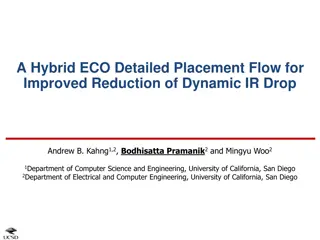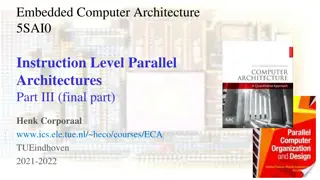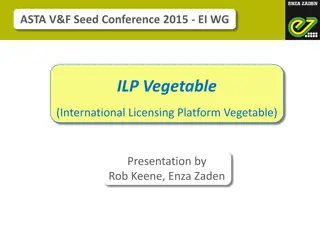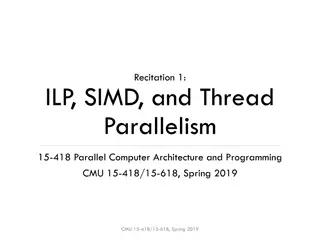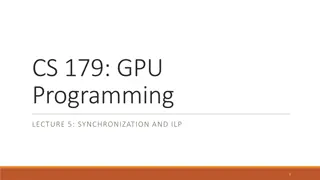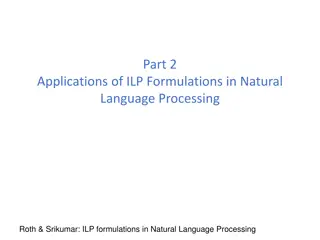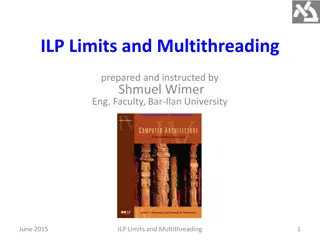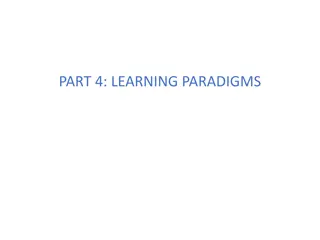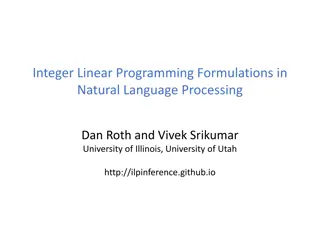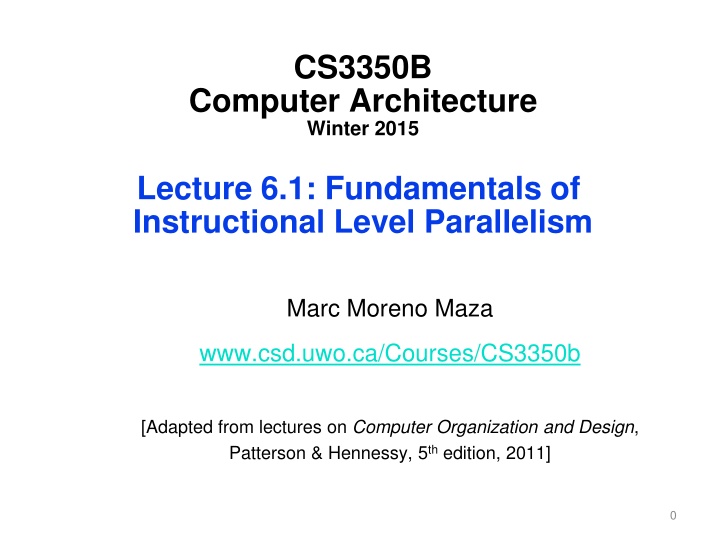
Fundamentals of Instructional Level Parallelism in Computer Architecture
Explore the concepts of instructional level parallelism in computer architecture through analogies with laundry tasks, understanding sequential versus pipelined processes, and the impact on speedup. Dive into MIPS instruction formats and the five stages of executing MIPS instructions for a comprehensive overview of the topic.
Download Presentation

Please find below an Image/Link to download the presentation.
The content on the website is provided AS IS for your information and personal use only. It may not be sold, licensed, or shared on other websites without obtaining consent from the author. If you encounter any issues during the download, it is possible that the publisher has removed the file from their server.
You are allowed to download the files provided on this website for personal or commercial use, subject to the condition that they are used lawfully. All files are the property of their respective owners.
The content on the website is provided AS IS for your information and personal use only. It may not be sold, licensed, or shared on other websites without obtaining consent from the author.
E N D
Presentation Transcript
CS3350B Computer Architecture Winter 2015 Lecture 6.1: Fundamentals of Instructional Level Parallelism Marc Moreno Maza www.csd.uwo.ca/Courses/CS3350b [Adapted from lectures on Computer Organization and Design, Patterson & Hennessy, 5thedition, 2011] 0
Analogy: Gotta Do Laundry Ann, Brian, Cathy, Dave each have one load of clothes to wash, dry, fold, and put away A B C D Washer takes 30 minutes Dryer takes 30 minutes Folder takes 30 minutes Stasher takes 30 minutes to put clothes into drawers 1
Sequential Laundry 2 AM 12 6 PM 1 8 7 11 10 9 30 30 30 30 30Time 30 30 30 30 30 30 30 30 30 30 30 T a s k A B C D O r d e r Sequential laundry takes 8 hours for 4 loads 2
Pipelined Laundry 2 AM 12 6 PM 1 8 7 11 10 9 Time 30 30 30 30 30 30 30 T a s k A B C D O r d e r Pipelined laundry takes 3.5 hours for 4 loads! 3
Pipelining Lessons (1/2) Pipelining doesn t help latency of single task, it helps throughput of entire workload 6 PM 7 8 9 Time T a s k 30 30 30 30 30 30 30 Multiple tasks operating simultaneously using different resources A B C O r d e r Potential speedup = Number of pipe stages D Time to fill pipeline and time to drain it reduces speedup: 2.3x vs. 4x in this example 4
Pipelining Lessons (2/2) Suppose new Washer takes 20 minutes, new Stasher takes 20 minutes. How much faster is pipeline? 6 PM 7 8 9 Time T a s k 30 30 30 30 30 30 30 A Pipeline rate limited by slowest pipeline stage B C O r d e r Unbalanced lengths of pipe stages reduces speedup D 5
Recap: MIPS Three Instruction Formats 31 25 20 15 10 5 0 R-format: op rs rt rd shamt funct 31 25 20 15 0 I-format: op rs rt address offset 31 25 0 J-format: op target address Examples: R-format: add, sub, jr I-format: lw, sw, beq, bne J-format: j, jal 6
Recap: Five Stages in Executing MIPS (1) Instruction Fetch (IFetch) Fetch an instruction; increment PC (2) Instruction Decode (Dec) Decode instruction; read registers; sign extend offset (3) ALU (Arithmetic-Logic Unit) (Exec) Execute R-format operations; calculate memory address; branch comparison; branch and jump completion (4) Memory Access (Mem) Read data from memory for load or write data to memory for store (5) Register Write (WB) Write data back to register 7
Graphical Representation registers rd instruction memory PC memory rs Data ALU rt imm +4 2. Decode/ Register Read 1. Instruction Fetch 3. Execute 4. Memory5. Register Write Short name: IFetch Dec Exec Mem WB Graphical Representation: ALU I$ D$ Reg Reg 8
Single Cycle CPU Clocking All stages of an instruction completed within one long clock cycle Clock cycle sufficiently long to allow each instruction to complete all stages without interruption within one cycle 1. Instruction Fetch 2. Decode/ Register Read 3. Execute 4. Memory5. Reg. Write 9
Single Cycle Performance Assume time for actions are 100ps for register read or write 200ps for other events Clock rate of the single cycle datapath is? Instr Total time Instr fetch 200ps Register read 100 ps ALU op Memory access 200ps Register write 100 ps lw 200ps 800ps sw 200ps 100 ps 200ps 200ps 700ps R-format 200ps 100 ps 200ps 100 ps 600ps beq 200ps 100 ps 200ps 500ps What can we do to improve clock rate? Will this improve performance as well? Want increased clock rate to mean faster programs 10
Multiple-cycle CPU Clocking Only one stage of instruction per clock cycle Clock is made as long as the slowest stage 1. Instruction Fetch 2. Decode/ Register Read 3. Execute 4. Memory 5. Register Write Advantages over single cycle execution: Unused stages in a particular instruction can be skipped OR instructions can be pipelined (overlapped) 11
How Can We Make It Faster? Split the multiple instruction cycle into smaller and smaller steps There is a point of diminishing returns where as much time is spent loading the state registers as doing the work Start fetching and executing the next instruction before the current one has completed Pipelining (all?) modern processors are pipelined for performance Remember the performance equation: CPU time = CPI * CC * IC Fetch (and execute) more than one instruction at a time Superscalar processing stay tuned 12
A Pipelined MIPS Processor Start the next instruction before the current one has completed improves throughput - total amount of work done in a given time instruction latency (execution time, delay time, response time - time from the start of an instruction to its completion) is not reduced Cycle 1 Cycle 2 Cycle 3 Cycle 4 Cycle 5 Cycle 6 Cycle 7 Cycle 8 IFetch Dec Exec Mem WB lw IFetch Dec Exec Mem WB sw IFetch Dec Exec Mem WB R-type - clock cycle (pipeline stage time) is limited by the slowest stage - for some instructions, some stages are wasted cycles 13
Why Pipeline? For Performance! Under ideal conditions and with a large number of instructions, the speed-up from pipelining is approximately equal to the number of pipe stages. A five-stage pipeline is nearly five times faster. Time (clock cycles) Once the Inst 0 ALU I$ D$ Reg Reg I n s t r. pipeline is full, one instruction is completed every cycle, so CPI = 1 Inst 1 ALU I$ Reg Reg D$ ALU Inst 2 D$ I$ Reg Reg O r d e r ALU Inst 3 I$ Reg Reg D$ ALU D$ Inst 4 I$ Reg Reg Time to fill the pipeline 14
Pipeline Performance Assume time for stages is 100ps for register read or write 200ps for other stages What is pipelined clock rate? Compare pipelined datapath with single-cycle datapath Instr Total time Instr fetch 200ps Register read 100 ps ALU op Memory access 200ps Register write 100 ps lw 200ps 800ps sw 200ps 100 ps 200ps 200ps 700ps R-format 200ps 100 ps 200ps 100 ps 600ps beq 200ps 100 ps 200ps 500ps 15
Pipeline Performance Single-cycle (Tc= 800ps) Pipelined (Tc= 200ps) 16
Pipeline Speedup If all stages are balanced (i.e. all take the same time) and there are no dependencies between the instructions, CPI = 1 (each instruction takes 5 cycles, but 1 completes each cycle) Ideal speedup is: Time between instructionsnonpipelined Number of stages = Time between instructionspipelined Speedup due to increased throughput; Latency (time for each instruction) does not decrease If not balanced, speedup is less Pipelining the three lw, speedup: 2400ps/1400ps = 1.7 Add 1000,000 more instructions, the speedup: (10^6*200+1400)/(10^6*800+2400) ~ 800/200 = 4 17
MIPS Pipeline Datapath Modifications What do we need to add/modify in our MIPS datapath? Add State registers between each pipeline stage to isolate them IF:IFetch ID:Dec EX:Execute MEM: WB: MemAccess WriteBack Add Add Shift left 2 4 Read Addr 1 Register Instruction Memory Data Memory IFetch/Dec Read Data 1 Read Addr 2 File Exec/Mem Dec/Exec Read Address PC Read Data Mem/WB Address ALU Write Addr Read Data 2 Write Data Write Data Sign Extend 16 32 System Clock 18
Pipelining the MIPS ISA MIPS Instruction Set designed for pipelining All instructions are 32-bits Easier to fetch and decode in one cycle x86: 1- to 17-byte instructions (x86 HW actually translates to internal RISC instructions!) Few and regular instruction formats, 2 source register fields always in same place Can decode and read registers in one step Memory operands only in Loads and Stores Can calculate address at 3rd stage, access memory at 4th stage Alignment of memory operands Memory access takes only one cycle 19
Other Sample Pipeline Alternatives ARM7 IM Reg EX PC update IM access decode reg access ALU op DM access shift/rotate commit result (write back) Intel XScale Reg DM2 ALU IM1 DM1 IM2 Reg SHFT PC update BTB access start IM access decode reg 1 access DM write reg write ALU op start DM access exception shift/rotate reg 2 access IM access 20
Can Pipelining Get us Into Trouble? Yes: Pipeline Hazards structural hazards: attempt to use the same resource by two different instructions at the same time data hazards: attempt to use data before it is ready - An instruction s source operand(s) are produced by a prior instruction still in the pipeline control hazards: attempt to make a decision about program control flow before the condition has been evaluated and the new PC target address calculated - branch instructions Can always resolve hazards by waiting pipeline control must detect the hazard and take action to resolve hazards 21
Takeaway All modern day processors use pipelining Pipelining doesn t help latency of single task, it helps throughput of entire workload Potential speedup: a CPI of 1 and a faster CC Recall CPU time = CPI * CC * IC Pipeline rate limited by slowest pipeline stage Unbalanced pipe stages make for inefficiencies The time to fill pipeline and time to drain it can impact speedup for deep pipelines and short code runs Must detect and resolve hazards Stalling negatively affects CPI (makes CPI more than the ideal of 1) Compiler can arrange code to avoid hazards and stalls: Requires knowledge of the pipeline structure 22



